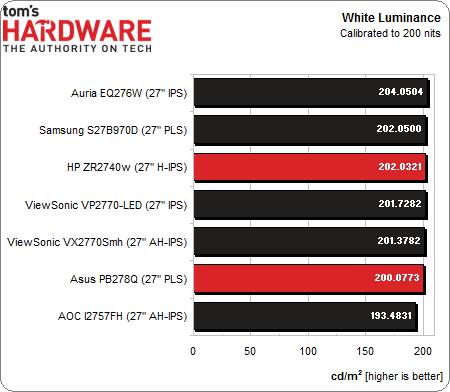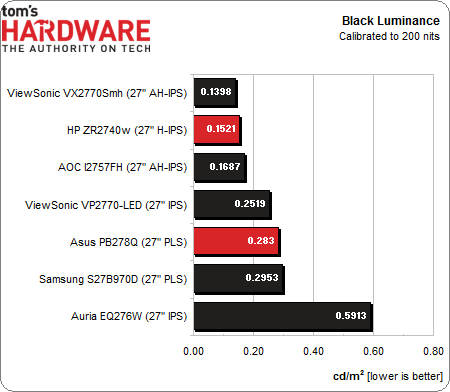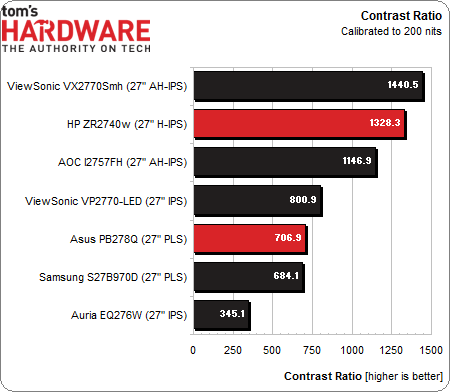HP ZR2740w Versus Asus PB278Q: QHD 27" Monitors, Tested
Until cutting-edge UHD (3840\00d72160) displays hit the mainstream, most enthusiasts have to be content with QHD monitors at 2560x1440 pixels. In the lab today, we have two more 27-inch QHD screens: the ZR2740w from HP and the PB278Q from Asus.
Results: Calibrated Brightness And Contrast
We consider 200 nits to be an ideal average for peak output, so we calibrate all of our test monitors to that value. In a room with some ambient light, such as an office, this brightness level provides a sharp, punchy image with maximum detail and minimum eye fatigue. It's also the sweet spot for gamma and grayscale tracking, which we'll look at on pages five and six.
This comparison normally includes a full grayscale calibration. Since the HP has no adjustments in that area, we simply set the brightness as close to 200 cd/m2 as possible.
Both monitors have little difficulty settling in at 200 cd/m2. The only way to do this on the HP is with a meter, since there is no other indication of the brightness level. The Asus PB278Q is set to 62 out of 100 for brightness and 75 out of 100 for contrast.
Calibration can sometimes raise the black level slightly, and some monitors are better at maintaining a low number than others.
The HP predictably stays near the top in this metric. It would be interesting to see how a grayscale calibration would affect this figure but, unfortunately, there’s no way to perform one. The Asus PB278Q also does extremely well with a very low 0.2830 cd/m2 measurement.
Maintaining a high contrast ratio after calibration is the toughest test for any monitor. Most screens take at least a small hit for the sake of color accuracy.
The HP has an unfair advantage because of its lack of calibration controls, but it looks great nonetheless. The Asus holds its own nicely at 706.9 to 1. Its image is still very punchy, and as you’ll see later, the color accuracy achieved is more than worth this small drop in measured contrast. It’s unlikely that you’ll be able to perceive any difference with the naked eye.
Get Tom's Hardware's best news and in-depth reviews, straight to your inbox.
Current page: Results: Calibrated Brightness And Contrast
Prev Page Results: Stock Brightness And Contrast Next Page Results: Gamma And ANSI Contrast Ratio
Christian Eberle is a Contributing Editor for Tom's Hardware US. He's a veteran reviewer of A/V equipment, specializing in monitors. Christian began his obsession with tech when he built his first PC in 1991, a 286 running DOS 3.0 at a blazing 12MHz. In 2006, he undertook training from the Imaging Science Foundation in video calibration and testing and thus started a passion for precise imaging that persists to this day. He is also a professional musician with a degree from the New England Conservatory as a classical bassoonist which he used to good effect as a performer with the West Point Army Band from 1987 to 2013. He enjoys watching movies and listening to high-end audio in his custom-built home theater and can be seen riding trails near his home on a race-ready ICE VTX recumbent trike. Christian enjoys the endless summer in Florida where he lives with his wife and Chihuahua and plays with orchestras around the state.


